god damn shunt is killing me
Discussion
Just wondered how you are getting on with this work?
I plan to try the pcv mod and move to full manifold vacuum this week some time so will report back with the findings.
I will try the pcv valve just above the flame trap as mentioned, on a yank ford 302 I had the pcv valve shown was in one rocker cover piped to manifold vacuum, and the other cover vented so a very similar setup.
I plan to try the pcv mod and move to full manifold vacuum this week some time so will report back with the findings.
I will try the pcv valve just above the flame trap as mentioned, on a yank ford 302 I had the pcv valve shown was in one rocker cover piped to manifold vacuum, and the other cover vented so a very similar setup.
Tried switching to full manifold vacuum yesterday and noticed the car running cooler and a fair bit more responsive low down.
Cant give any timing figures yet as my light is knackered but it should be as standard. No noticeable pinking but thats pretty hard to hear with a clive y!
I do prefer the way it feels on the road.
Cant give any timing figures yet as my light is knackered but it should be as standard. No noticeable pinking but thats pretty hard to hear with a clive y!
I do prefer the way it feels on the road.
I saw un uplift of 600 RPM at idle as I switched across, ( then over ridden by the stepper after a few seconds) so the engine certainly runs better at idle. No perceptible change apart from that, but that's as you would expect, as the porting only alters the vac advance at the point the throttle is near shut. It wont affect your total advance under load / cruse at all.
It’s best left to someone handy with the spanner’s as you need to mess around with hose sizes etc and find a source of full manifold vacuum.
This is the hose you will relocate
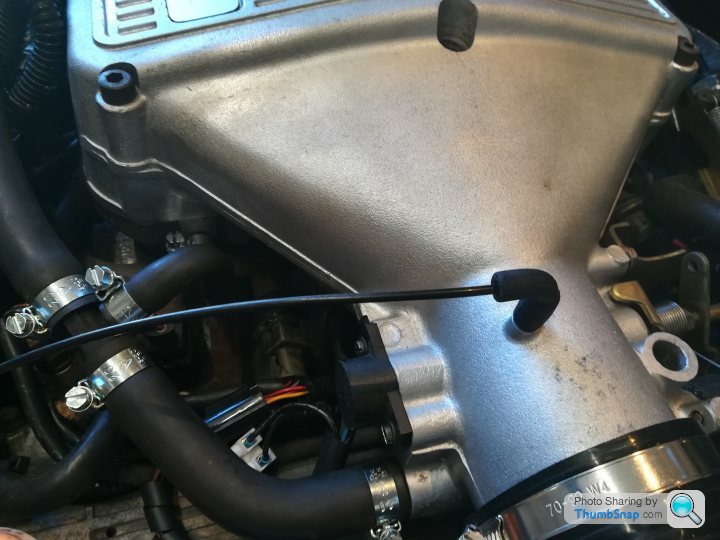
You blank it and relocate to full manifold vacuum.
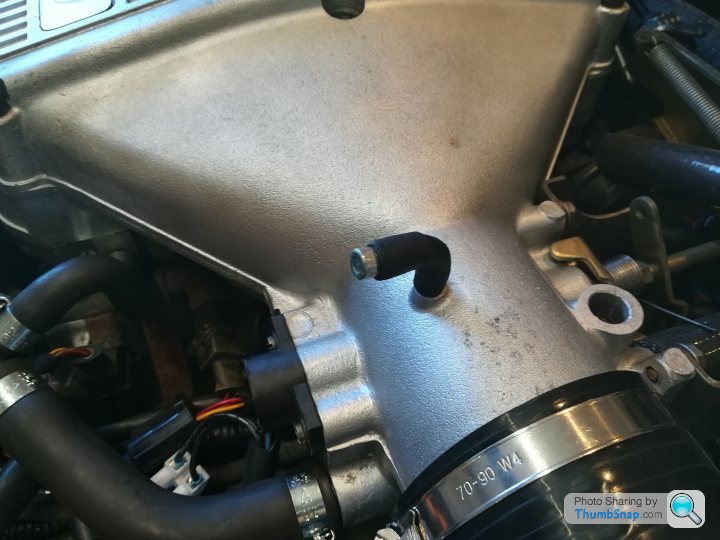
My source of full manifold vacuum but I have removed the charcoal canister system which used this port.
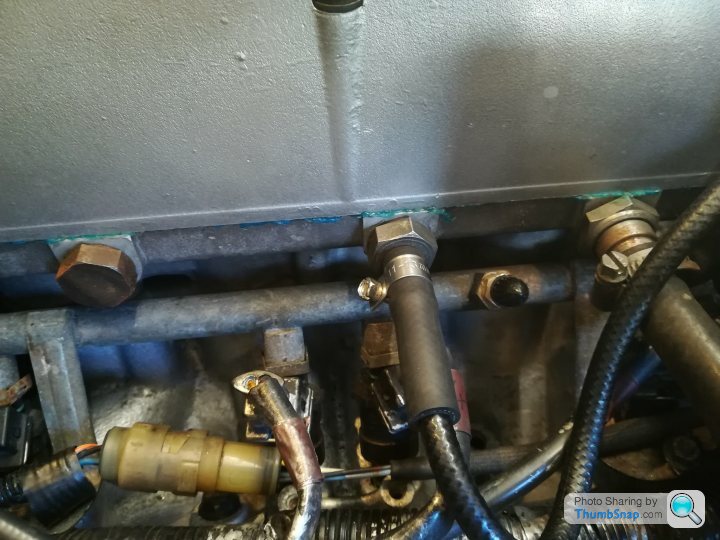
Not difficult but you would probably need to tee into the charcoal canister hose if you still have it fitted.
Hose to distributor
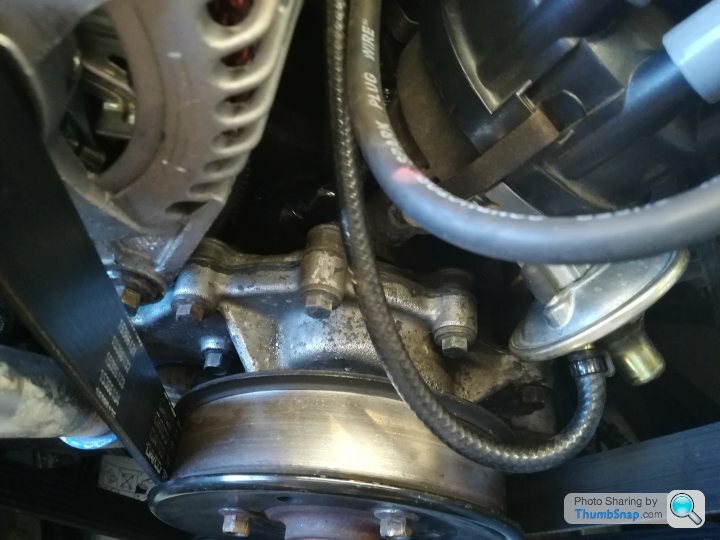
This is the hose you will relocate

You blank it and relocate to full manifold vacuum.

My source of full manifold vacuum but I have removed the charcoal canister system which used this port.

Not difficult but you would probably need to tee into the charcoal canister hose if you still have it fitted.
Hose to distributor

In picture 3 - the 3 take off points for full vacuum are shown - you can remove the blank on the left and fit an adaptor. Save teeing into another line?
This should fit okay (check with supplier for the thread size)
https://rimmerbros.com/Item--i-518425
This should fit okay (check with supplier for the thread size)
https://rimmerbros.com/Item--i-518425
N7GTX said:
In picture 3 - the 3 take off points for full vacuum are shown - you can remove the blank on the left and fit an adaptor. Save teeing into another line?
This should fit okay (check with supplier for the thread size)
https://rimmerbros.com/Item--i-518425
Good find that. This should fit okay (check with supplier for the thread size)
https://rimmerbros.com/Item--i-518425

I think it has to be pointed out to those who want to 'try' this mod is that first they must check what timing the car is running at and the mechanical range of advance that their distributor can give.
On my car, as my distributor only has 16 deg of mechanical advance, which I set to the 32 deg at 4k that the bible says is right for a 400, then my car is now idling at 16 deg.
If someone has the same setup as me, or even with it set at 28 deg at 4k rpm, then blindly changing the position of the vacuum hose to the manifold would add another 10 ish degrees and thus it will be idling at somewhere around 26 deg.
I know those in the aftermarket ECU world can deal with parts of the rpm range being in this area, but they can also dial it up and down very differently adding to the engine's efficiency, as opposed to the way a mechanical distributor does it.
On my car, as my distributor only has 16 deg of mechanical advance, which I set to the 32 deg at 4k that the bible says is right for a 400, then my car is now idling at 16 deg.
If someone has the same setup as me, or even with it set at 28 deg at 4k rpm, then blindly changing the position of the vacuum hose to the manifold would add another 10 ish degrees and thus it will be idling at somewhere around 26 deg.
I know those in the aftermarket ECU world can deal with parts of the rpm range being in this area, but they can also dial it up and down very differently adding to the engine's efficiency, as opposed to the way a mechanical distributor does it.
tell you what .. put 36 degrees total advance in, drive up a long hill flat out on a hot day (like today, perfect opportunity) and report back what happens..*
presumably that number was given to you by a head gasket retailer ?
presumably that number was given to you by a head gasket retailer ?
- slight exagerration for effect, but 36 degrees is a very high number .. Ive just run through a selection of emerald maps and the most I ever put into one was 38 degrees (large capacity 5.5 with a H404 cam so very much a high rpm large chamber engine and very much the exception in the RV8 world and even that was only 31 degrees at under 4000rpm, the advance was there to offset the vastly inferior chamber filling past peak torque of the 5.5 drawing through what are still very small valves even on a st4 head)
Edited by spitfire4v8 on Friday 29th June 16:00
spitfire4v8 said:
tell you what .. put 36 degrees total advance in, drive up a long hill flat out on a hot day (like today, perfect opportunity) and report back what happens..*
presumably that number was given to you by a head gasket retailer ?
Good to know, always better to listen to the experts!presumably that number was given to you by a head gasket retailer ?
- slight exagerration for effect, but 36 degrees is a very high number .. Ive just run through a selection of emerald maps and the most I ever put into one was 38 degrees (large capacity 5.5 with a H404 cam so very much a high rpm large chamber engine and very much the exception in the RV8 world and even that was only 31 degrees at under 4000rpm, the advance was there to offset the vastly inferior chamber filling past peak torque of the 5.5 drawing through what are still very small valves even on a st4 head)
Edited by spitfire4v8 on Friday 29th June 16:00
Thanks
My findings are
12 degrees btdc static.
Full manifold vacuum, adding 6 degrees at idle so its roughly 18 degrees btdc.
Total timing all in 30 degrees.
Car is a lot more responsive low down, feels like its gained more torque.
Running temp also down by roughly 10 degrees on the gauge.
Cant see a down side to this modification.
As already mentioned you need to check your timing figures before carrying it out.
Every car will be different.
12 degrees btdc static.
Full manifold vacuum, adding 6 degrees at idle so its roughly 18 degrees btdc.
Total timing all in 30 degrees.
Car is a lot more responsive low down, feels like its gained more torque.
Running temp also down by roughly 10 degrees on the gauge.
Cant see a down side to this modification.
As already mentioned you need to check your timing figures before carrying it out.
Every car will be different.
Belle427 said:
My findings are
12 degrees btdc static.
Full manifold vacuum, adding 6 degrees at idle so its roughly 18 degrees btdc.
Total timing all in 30 degrees.
Car is a lot more responsive low down, feels like its gained more torque.
Running temp also down by roughly 10 degrees on the gauge.
Cant see a down side to this modification.
As already mentioned you need to check your timing figures before carrying it out.
Every car will be different.
Just the ticket, that's how to do it 12 degrees btdc static.
Full manifold vacuum, adding 6 degrees at idle so its roughly 18 degrees btdc.
Total timing all in 30 degrees.
Car is a lot more responsive low down, feels like its gained more torque.
Running temp also down by roughly 10 degrees on the gauge.
Cant see a down side to this modification.
As already mentioned you need to check your timing figures before carrying it out.
Every car will be different.

However, reading the comments of others there seems to be some sort of misconception that the old low compression Rover V8 is some sort of exception to what was learnt about ignition timing well over 60 years ago and remains unchanged to this day. Ask any Yank hot rodder what total timing he runs on his fairly stock compression small or big block Ford/Chevy OHV V8, those in the know tend to run between 32-34 degrees all out depending on the cam and compression.
And here's what your typical Yank hot rodder will do with his standard small block Chevy timing curve even on an engine in a mild state of tune.
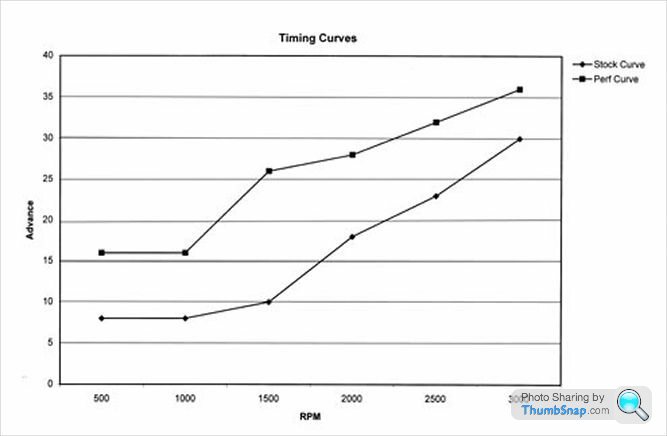
The above was taken from a good article on curves and all out timing from Super Chevy magazine which everyone should read.
http://www.superchevy.com/how-to/46178/
Back to the vac advance debate though and reading through the comments here it does seem people may be getting confused over when the vac advance unit is actually adding timing, the clue is in the word vacuum of course. When you go wide open throttle there is no vacuum so nothing is added, even under moderate acceleration the butterfly may be as much as 60-70% open so vacuum will be negligible, basically that vacuum advance is doing fek all.
If you idle at 10 degrees at 950rpm with no vac advance connected then connect it, once you've wound in your base idle screw to bring the idle back down to 950rpm you'll likely see 18 degrees as others have reported, this because the throttle butterfly is virtually closed and the engine is pumping away, so vacuum is relatively high. But that doesn't mean when you accelerate to 3,500rpm when your dizzy is all done adding mechanical timing at 28 degrees the vac advance unit is still going to add it's 8-10 degrees, you'd be lucky to see a degree or two from it and in practice more likely nixy!
All running full vacuum to your vac advance is going to give you is a smoother idle, lower under bonnet temps, and worse emissions if that bothers you? What you're looking for is what every old school hot rodder knows to run his V8 at, because the Rover V8 really is no different to what the Yanks have, 16-18 degrees at idle and 32 degrees all out at peak torque is well know to be optimal. If you have a programmable distributorless ignition system all the better because as you pass over the crest of peak torque you may well find it advantageous to start pulling a degree of timing for every 500rpm beyond that point, obviously this is something you can't do with a distributor.
Finally if people are still convinced the Rover V8 is some special case they only need look at a Jap export MGB RV8, as we all know this vehicle ran the exact same Rover V8 engine, inlet manifold, plenum and engine management system as our cars but Jap market MGB RV8 mysteriously ran the vac advance connected to full vacuum
 , not the emissions friendly ported setup we and the Yank export Rangies & Discos got
, not the emissions friendly ported setup we and the Yank export Rangies & Discos got  .
.Obviously people need to understand the theory of ignition timing and engage their brain, they should also buy a timing light/strobe (preferably a dial back one) before progressing if they dont ave one already. But running the vac advance to full vacuum isn't the danger here, it's good old fashioned over advancing the distributor which quite clearly is a mistake the ignorant could make just as easily while still running on ported vacuum

More good reading here...
http://garage.grumpysperformance.com/index.php?thr...
But if you can't be bothered to read it all, here's a good snippet....
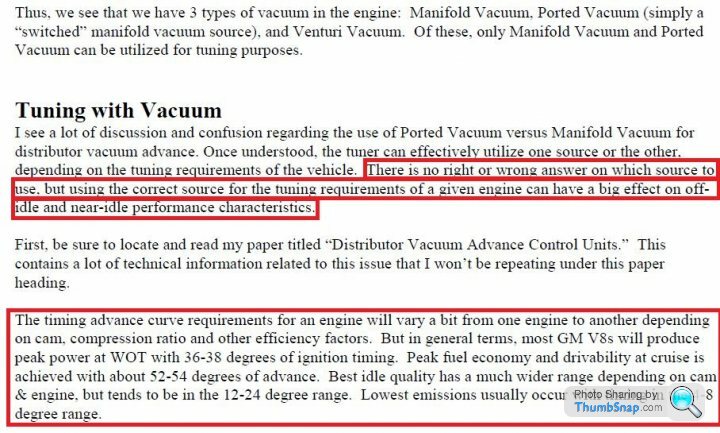
http://garage.grumpysperformance.com/index.php?thr...
But if you can't be bothered to read it all, here's a good snippet....

Belle427 said:
It’s best left to someone handy with the spanner’s as you need to mess around with hose sizes etc and find a source of full manifold vacuum...
My source of full manifold vacuum but I have removed the charcoal canister system which used this port.

Belle427 have you found the levels of full manifold vacuum consistent and stable from the plenum port? I was thinking of doing this mod but on reading the article below I have some reservations, especially if 'induction pulsing' as mentioned is a factor and considering the plenum works as a Helmholtz resonator it could be:My source of full manifold vacuum but I have removed the charcoal canister system which used this port.

Article from https://www.minimania.com/SU_Carbs_HIFa_more_finely_honed_instrument:
Vac pipe take-off - There's always something to spoil the party! On some HIF carbs, the vac take-off sighted just after the butterfly - that's between the butterfly and the carb to manifold mounting flange - has been eliminated. Instead, the engines these carbs are fitted to use a vac take off in the manifold. The reason for this is again wholly idle emissions orientated. The higher vacuum that exists in the manifold area can be used to pull more advance. Theoretically this will reduce emissions at idle. Unfortunately it's exposed to induction pulsing. In the A-series, this is UGLY. The pulsing and high manifold vacuum causes rough idling. Particularly where anything 'sportier' (ANYTHING) than a bog-stock-standard cam profile is used.
Classic example - the MG Metro. Its adventurously sporty cam makes for a slightly lumpy idle. This increases idle speed emissions, so Rover use manifold-sourced vacuum to increase idle speed ignition timing via the vac advance. We're talking 28 degrees of ignition timing here! Doesn't work because the pulsing created by the cam causes erratic ignition timing, culminating in running on. So an anti-run-on valve was fitted as a modification. Vicious circle. After messing about trying to solve the emission problems this caused, it was found that changing the originally quoted valve clearances to 0.014"inlet /0.017" exhaust (effectively reducing the cam over-lap) helped dramatically. And, like I said earlier, the sportier the profile, the worse it becomes. Even worse - when running, this system can cause ignition advances in the order of 50 degrees on lift-off and on again - an absolute sure-fire recipe for savage detonation.
The solution is easy - remove the vac take-off from the manifold and fit it back to just in front of the butterfly where it should be.
Also, if you have RoverGauge and the time could you check that with manifold vacuum from the plenum fitted and when at steady idle, fuel cell selection in the fuel map is not jumping around from cell to cell as vacuum and therefore ignition advance rises and falls due to pulsing.
Many thanks.
Edited by davep on Monday 23 July 10:29
Gassing Station | Chimaera | Top of Page | What's New | My Stuff




